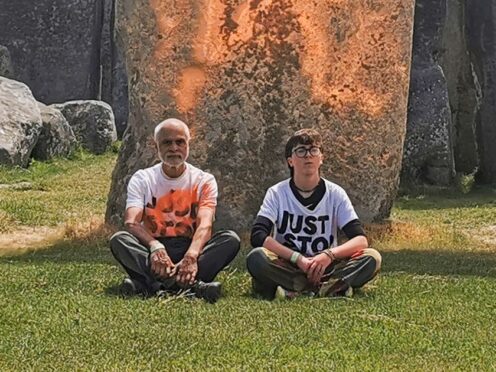
Two activists from Just Stop Oil have sprayed orange paint on the prehistoric Stonehenge stones.
Members of the public were heard shouting “no” and running to intervene as the campaigners, named by the group as Rajan Naidu, 73, and Niamh Lynch, 21, ran up to the stone circle on Wednesday.
Video footage posted on social media showed two people wearing white shirts with the slogan Just Stop Oil, approaching the monoliths with canisters spraying orange paint.
🚨 BREAKING: Just Stop Oil Spray Stonehenge Orange
🔥 2 people took action the day before Summer Solstice, demanding the incoming government sign up to a legally binding treaty to phase out fossil fuels by 2030.
🧯 Help us take megalithic action — https://t.co/R20S8YQD1j pic.twitter.com/ufzO8ZiDWu
— Just Stop Oil (@JustStop_Oil) June 19, 2024
Several of the iconic stones – dating back to the late Neolithic period – were seen covered in orange paint before one protester sat on the grass and the other was detained by a member of the public.
The incident happened on Wednesday at about 12pm, the day before the summer solstice is celebrated at Stonehenge, which is the heart of a World Heritage site.
In a statement, Just Stop Oil said its action was to demand that the incoming UK Government should agree a plan with other governments to end the extraction and burning of oil, gas and coal by 2030.
A spokesperson said: “The UK’s government in waiting has committed to enacting Just Stop Oil’s original demand of ‘no new oil and gas’. However, we all know this is not enough.
“Continuing to burn coal, oil and gas will result in the death of millions. We have to come together to defend humanity or we risk everything.
“That’s why Just Stop Oil is demanding that our next government sign up to a legally binding treaty to phase out fossil fuels by 2030.”

The group said it used orange cornflour paint to spray onto the stones, which it claimed would “soon wash away with the rain”.
Around 8,000 people gathered at Stonehenge to mark the longest day of the year in 2023, with similar numbers expected on Thursday.
The solstice will be celebrate from 7pm on Thursday until 8am on Friday.
In quotes provided by Just Stop Oil, Miss Lynch, said to be a student from Oxford, said the continued burning of oil, coal and gas was leading to “death and suffering”.
“It’s time for us to think about what our civilization will leave behind – what is our legacy?” she said.
“Standing inert for generations works well for stones – not climate policy.”
Just Stop Oil said Rajan Naidu, 73, from Birmingham, added: “Either we end the fossil fuel era, or the fossil fuel era will end us.

“Just as fifty years ago, when the world used international treaties to defuse the threats posed by nuclear weapons, today the world needs a Fossil Fuel Non-Proliferation Treaty to phase out fossil fuels and to support dependent economies, workers and communities to move away from oil, gas and coal.”
English Heritage describes Stonehenge as perhaps the world’s most famous prehistoric monument.
It was built in several stages, with the first an early henge monument erected about 5,000 years ago.
The stone circle was erected in the late Neolithic period, about 2,500 BC. Burial mounds were built nearby in the early Bronze Age.
Stonehenge, together with Avebury, forms the heart of a World Heritage Site.

Enjoy the convenience of having The Sunday Post delivered as a digital ePaper straight to your smartphone, tablet or computer.
Subscribe for only £5.49 a month and enjoy all the benefits of the printed paper as a digital replica.
Subscribe